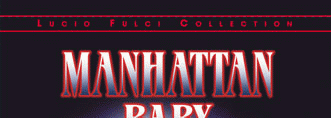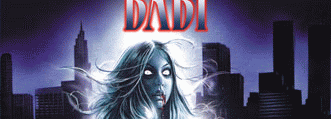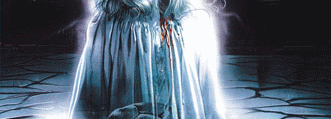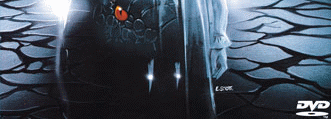Manhattan Baby starts off in Egypt where archaeologist George Hacker (Connelly) has gone to dig in the tombs of the pharaohs. He has taken his wife, Emily, and Susie (Briggita Boccoli, who is still making films in Italy), his daughter, with him. Their son, Tommy, stayed behind with Jamie Lee (Dead Meat Number Four), their nanny. Jamie Lee is played by Cinzia de Ponti, who was Miss Italy in 1979 and has had a very active film career (twenty-one film credits to date). Susie is in an Egyptian marketplace with her mom when the child meets up with a mysterious blind woman dressed in black. The mystery woman takes Susie's hand, tells her "Tombs are for the dead," and then a necklace appears out of nowhere in the girl's hand. Dead center in the middle of the necklace there is a bright blue stone. The same day that George is going to desecrate the tomb, his daughter will be corrupted and have a curse placed on her that will follow her back to America. Meanwhile, back at the dig, George is having troubles of his own. The workers are reluctant to desecrate the resting place of pharaohs, so George and an Egyptian man (Dead Meat Number One) go in by themselves. They see strange carvings and paintings on the wall. A spring-loaded snake flies out of a hole in the wall, only to be shot by the Egyptian. Usually these movies feature a spring-loaded cat: Fulci was feeling creative. There are questions in my mind about whether this snake is supposed to be several thousand years old, or whether generation after generation of his family has patiently waited in that wall for some poor sucker to wander in, or if it's a supernatural apparition. A first cousin of this snake appears later in the story in an apartment and then an office in New York City, so I'll go for Door Number 3 and figure it's an apparition. There's a knob which George can't resist turning, which then releases a trap and the floor falls away, causing the two men to fall to a lower level of the tomb. The Egyptian man is killed instantly when he's impaled on spikes. George survives, of course, and continues to explore. He finds a mysterious carving on the wall with a blue stone in the middle. George survives because he's the American Actor Whose…. In films like this, having that status would almost guarantee that the character would still be alive for the happy ending. However, Fulci violated this rule like a madman in the far superior The Gates of Hell in which he waxed Christopher George in about the middle (as best I remember) of the third act. So George had best not get too cocky here. What George doesn't know is that this design is identical to the necklace that's been given his daughter. If you sense a pattern emerging there, you're right. The blue stone glows with an unearthly light and then George is zapped in the eyes by blue rays of light. Blind! Somehow he finds his way out of the tomb and collapses in the sand. The Egyptian scenes are tremendous. They could hold their own against any mainstream, big budget studio film. The camerawork is great, the color and composition are tremendous, there's a nice feel of how big the desert is, and a real atmosphere of menace and mystery. If only this could have held up. The American family returns home to New York. Doctors tell George that it could be a year before he regains his sight, so he tries to resume normal life. This movie makes being an archaeologist look like a very well paid job: George and Emily (Martha Taylor, in her only credited film role) live on the Upper West Side at 84th Street and West End Avenue in a huge apartment. Scenes in Central Park and on city streets - we get a glimpse of the Guggenheim Museum- establish that Fulci is indeed filming in Manhattan but, at the risk of being picky, ain't no baby. Both Susie and Tommy appear to be about eleven years old. So Fulci would more accurately have called this Manhattan Child or Manhattan Pre-Adolescent, but that wouldn't have the cross reference to Roman Polanski's 1968 masterpiece. One night Susie announces that she has a "premonition" of thunder and lightning. The adults in the household scoff at this statement, telling her that it's going to be a beautiful night. Not surprisingly, seconds later a huge thunderstorm strikes. Susie goes to sleep, and dreams of the mysterious woman in the marketplace. She tells her parents about this and passes out cold. Thus endeth Act I. The next day Susie's eyes glow with an eerie blue light. She and her brother are playing in their room. Emily is at work. Tommy walks from the apartment into another dimension. George hears shouts and runs upstairs. "Daddy help me," is written on the mirror in the children's room. Of course, George is blind at this point but I feel churlish pointing this out. A child wouldn't think about that. Suddenly, from nowhere two intense beams of blue light strike George in the eyes and his sight is restored. I've often read that Fulci has sort of a fetish about eyes. It shows here. There's the blind woman, her vision destroyed by cataracts. The Egyptian who goes into the tomb with George loses both eyes when he's impaled. George is blinded. There are close-up shots of eyes filling the wide screen over and over. George once was blind but now can see, just like the hymn. The children have mysteriously disappeared and then just as mysteriously reappeared. Susie has passed out cold after a bad dream. And nobody seems really disturbed about this. Of course we never see the family before the fateful trip to Egypt: maybe this is just daily life for them. Which is why I maintain that movies are better than real life. People can be dumb as bricks and still have beautiful homes and wonderful children. George and Emily have a car but never have a problem finding parking spaces. It seems that nobody's job involves strict working hours. George Carlin said it best. Reality, what a concept!
The unfortunate security man gets into the elevator- the walls are bright primary red- and goes not to the floor where apartment 623 would be, but rather to the top floors of the building. Then the elevator begins to malfunction. It quakes as if the earth were trembling. He pushes buttons. Nothing. The terrified man tries to pry the doors of the elevator open by sheer strength and will, but only succeeds in cutting his hands to shreds. Then the floor of the elevator separates from the cage, plunging the man into the darkness below to certain death. When it becomes obvious that building security won't be coming, Jamie Lee calls Emily at work and tells her that the door of the children's room is stuck and she can't open it. Either she's forgotten about the cobra (which doesn't make an appearance again until the third act) or else the footage with it was edited in after the telephone scene was shot. Or, of course, maybe this is just one of those things if you take care of Professor and Mrs. Hacker's children. Need one add that there is never any mention of the unfortunate security man again, nor of the elevator with the breakaway floor? Emily is at her job in the Time/Life Building. It's uncertain which publication she works for, but she's in an office with a lot of typewriters so it must be some print medium. Her buddy Luke (Dead Meat Number Three) says he'll go back to the house with Emily. Luke is a practical joker, given to wearing glasses with funny noses and doing magic tricks. He's almost as annoying a character as Jar Jar Binks, and viewers can take comfort in knowing that he won't be around for long. Arriving at the apartment, Luke announces to Jamie Lee and Emily that he can open the door. He goes up the stairs intoning phrases like "hocus pocus," as if he were going to put a spell on the door to make it open. The door opens very easily and he walks into the room. There's a blinding flash of light, a bloodcurdling scream, and he's gone. The floor of the children's room is covered with sand at least a foot thick. Rushing in to see what has happened, Emily sees a scorpion burrow its way down into the sand. Emily dismisses this as a practical joke on Luke's part. This woman is allowed to have children, drive a car, and vote? Lord help us all. There's over a hundred cubic feet of sand in there. He carried it in his pockets? In an amazing concession to The Way Things Are in the Real World, a phone call is made to the office to see if he's gone back there. Emily does suggest calling the police (duh) but this idea is rejected immediately. Half a world away in the Egyptian desert Luke's lifeless body lies in the sand, his eyes frozen with terror. And we're starting to get an idea of why he and the other men have met such sad fates. Beards. They, and Dead Meats Five and Six, all have beards. Were I writing this for Psychology Today I'd dig out my old psych texts to see what Freud said about beards, but since he also had one (and so do I) that issue will have to go unanswered. Jamie Lee and the children go to Central Park on a beautiful, sunny day. She takes a Polaroid picture of them, but it is blank. They toss it aside (litterbugs!) and go on. A mysterious woman picks it up. The picture finally develops. It shows the Manhattan skyline but not the children, although the necklace is seen suspended in mid air. Emily is walking along 10th Street when a woman calls to her from an upper floor, telling her that she has information about her children. Emily gets in her car, which is parked right in front of Adrian Mercato's antique store (see, I told you movies were better than real life, parking places right where you need them) and drives home. George is agitated. His colleague Robert (Dead Meat Number Five) has examined the sand from the children's room and found it to be silt from the Nile. And Jamie Lee has disappeared. Actually, Jamie Lee has gone on a voyage. Tommy helpfully tells us that Jamie Lee screams every time she goes on a voyage- the blue stone somehow has power over trivial things like time and space- and adds, "Poor Jamie Lee," a curtain line which ends the second act. Act III opens with another set piece. Robert is in his study looking at the picture of the necklace. A cobra glides silently along the inlaid wood floor, and there's some really nice camerawork from the snake's point of view. It bites Robert, he dies foaming at the mouth, and we suppose the snake wisely heads back to Egypt by whatever means before the New York winter. Robert dies with the picture in his hand, but it disappears and reappears in Susie's hand. George- credit where credit is due- is beginning to think that something just may be wrong here. Tommy hands him a statue of Anubis, which he picked up "on a riverbank" while on a voyage. Maybe it's time to call in outside help. Off to 10th Street to see Adrian Mercato (Dead Meat Number Six)- and don't you just know they parked right in front of the store. Mercato- a mysterious character who looks somewhat sinister and has the same name as a character in Rosemary's Baby- is an older man. Bearded. You know it, don't you. You see it coming. Dead Meat Number Six will be involved in yet another set piece, but later in the story. Mercato tells them that Susie has absorbed the energy of the stone and is in great danger. He goes on to explain how some stones will absorb the energy of those who wear them when we finally realize what he is saying but nobody connected with the film is willing to let him put into words. It's clear. It's obvious. Your daughter is a mood ring. But he doesn't say it. Drat. Mercato goes to the apartment. He's upstairs with Susie when the parents hear her cry out "Mama, help me," and they rush up the stairs and see Mercato rolling on the floor, foaming at the mouth, and talking in Susie's voice. Father Damien Karras leaps to his feet and crashes through the window, falling to the foggy Georgetown street below and rolling down the long flight of steps. An older priest rushes up to him to administer the Last Rites and Christine MacNeil watches in horror as the man who has saved her daughter from Pazuzu…..oh…..sorry…wrong movie…it just reminded me so much of…..well…anyway….. Mercato tells George (I'm back, it's ok, I'm back) that the stone has power over time and space. Good work. Susie, who has developed the habit of glowing (the child will never need a nightlight again) winds up in New York Hospital. That's the name on the building. Tidy, generic. Her condition worsens. Her doctors are mystified. One of the doctors (the one with glasses and a moustache) is played by Fulci himself, doing an Alfred Hitchcock. It should be noted here that one of the other doctors does have a beard but somehow he escapes director Fulci's wrath. Susie gets worse and worse. Finally Mercato decides to intervene- for no reason indicated in either the screenplay, performances, or direction. But he substitutes himself for Susie, she is redeemed. Redeemed. That's the word Marcato uses. This is a completely selfless act on Mercato's part. Now, it's fine for a character to do something totally unexpected- there's a tremendous scene in Jeepers Creepers in which one character, finally confronting the demon in the climactic scene upstairs at the police station, steps in front of another character and tells the monster, Take me instead, I'm stronger and smarter. That was a surprise. This is simply confusing. Mercato gives George the necklace and tells him to throw it into the deepest, darkest part of the river. George obeys and the last we see of him he's tossing the necklace into the Hudson River, where the pollution should corrode it to nothing in a few months. Mercato is now alone in his antique store on Tenth Street. He hears the flutter of wings. Suddenly stagehands climb on ladders and tie strings to the stuffed birds that line the walls of the store and swing them at Mercato, and he pretends to be afraid of them. Well, excuse me. That's exactly what happens. The birds are supposed to come to life and peck him to death. The blessing and curse of a DVD is a bright super-clear picture and the wires on the birds are as visible as Dallas. There are some effective scenes of birds pecking at his face, but the long shots let us see the wires once too often. He cries "Birds of darkness, consume me," and the birds eat their lunch. Him. Coda. We're back in Egypt. The old blind woman approaches yet another young girl. She takes the girl's hand. Out of nowhere the mysterious necklace with the blue stone appears in the girl's hand, opening the door for a sequel should anyone ever wish to make one.
Last winter I taught high school English. We started the semester off with the 1968 film of Romeo and Juliet directed by Franco Zeffirelli. In introducing the film, I asked the students a thought question. In the nine Friday the Thirteenth films released so far (I'm eagerly awaiting Jason X this Spring) we've seen over a hundred characters their age slaughtered like cattle. Had they or anyone they knew or knew of cried during one? Of course not. Characters in those movies exist only to be sacrificed on Jason's blade. Period. They are targets not in a shooting gallery but a stabbing gallery. The same is true in Manhattan Baby, but it lacks the narrative drive that makes the Fridays so entertaining. They are paced like a rocket. Fulci's pacing is slow and stately, as if he were directing Strindberg or Pinter but with gore effects. An Egyptian man helping George is impaled on spikes? He was on salary. Luke is zapped in New York and his body lands in Egypt? No loss, he was a pain anyway. Robert is bitten by a cobra in a city not known for wildlife? OK. Jamie Lee falls prey (offscreen) to the forces of e-e-evil? Pity. The security man plunges however many floors to his doom? He was only onscreen for a couple of minutes. Mercato is the only character we might feel anything for because of the sacrifice he makes for Susie, but because of his uncertain motives his death is just one more set piece. The parents are mere stick figures. They are both incredibly stupid people who cannot understand what's going on around them and are more bewildered by life than Forrest Gump. Heck, in his playing Dr. Forester we see Fulci give the most fully developed role to himself. He's a medical doctor, he's concerned about the girl's well being, he has a moustache and wears glasses, and he smokes a pipe. By comparison to the other characters, we know tons about this man even though he has only a tiny function in the story. It's difficult to evaluate performances in a film which is dubbed. All the actors seem thoroughly professional, but without hearing their original voices it's hard to tell. The dubbing is very, very good. Some of the actors beside Christopher Connely may also have been speaking English. Martha Taylor, as noted earlier, didn't make any other films and the IMDB tells nothing about her origins. The strongest points of the film are the wide-screen camerawork and, oddly enough, the music. There are two main musical strains at work here. In the scenes in Egypt the music reminded me of the group Goblin, which provided music for many of Dario Argento's films, notably Suspiria. For the street scenes in New York the music is bluesy, jazz-accented. And, as noted earlier, the movie looks great. Which leads me to conclude with a….. ….. On a scale of one to five, Pops gives Manhattan Baby three mysterious blue stones. Parent's note: there's violence but no profanity, sex, or nudity. This wouldn't be disturbing to anyone high school age or older; but it wouldn't necessarily hold their interest, either. RATING:
A Smoothie of a horror movie. - March 29, 2002 |
||||||||||
|
|

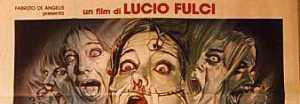
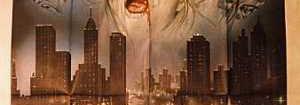
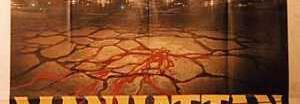
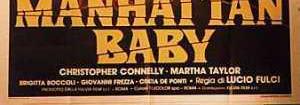
 Tommy
and Susie decide they want to play hide and seek with Jamie Lee.
During the course of the game the lights go out. It's not the
circuit breakers. Then, to make things worse, Jamie Lee discovers
a snake in the apartment. Not just any snake, but a cobra- not
what you'd expect to find on the sixth floor of a building on
the Upper West Side. She calls the building's security man (Dead
Meat Number Two), which lines up events for a set piece that's
very similar to a scene in The Omen II.
Tommy
and Susie decide they want to play hide and seek with Jamie Lee.
During the course of the game the lights go out. It's not the
circuit breakers. Then, to make things worse, Jamie Lee discovers
a snake in the apartment. Not just any snake, but a cobra- not
what you'd expect to find on the sixth floor of a building on
the Upper West Side. She calls the building's security man (Dead
Meat Number Two), which lines up events for a set piece that's
very similar to a scene in The Omen II.